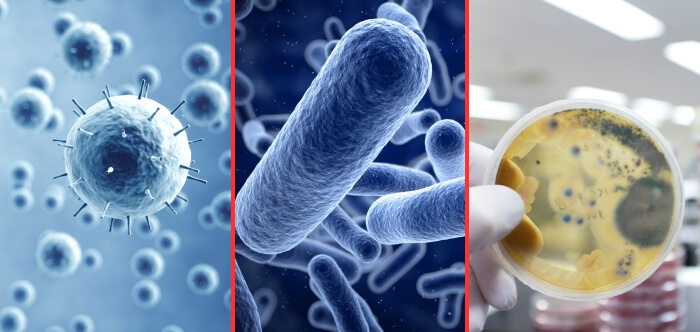Your toothbrush, a trusty companion in your daily oral care routine, may harbor hidden secrets that could impact your dental health. Have you ever wondered, how long do germs live on toothbrushes? It's a question that often goes unaddressed, yet the answer holds important implications for your overall well-being.
The surprising truth is that germs and viruses can set up camp on your toothbrush head for weeks. Even after an illness, they cling constantly, setting up a microbial comeback, primed for a return engagement in your mouth.
In this blog, we're exploring how long germs stick around on your toothbrush and what it means for your oral health. You'll also find practical tips to keep your toothbrush clean and maintain a healthy smile. If you're curious about the germs on your toothbrush, read on. We're revealing the truth about how long they hang around.
An In-Depth Analysis of Toothbrush Germs
Maintaining oral hygiene is a cornerstone of overall health, but have you ever considered the microbial world that dwells on your toothbrush? Germs are not just confined to unsanitary environments; they can also take residence on the bristles of your toothbrush. These microscopic inhabitants can potentially impact your oral health.

Toothbrushes often play host to a variety of germs, including bacteria and viruses. When you brush your teeth, these microorganisms can transfer onto your dental surfaces, posing potential risks. Understanding how long germs can survive on your toothbrush and adopting effective hygiene practices can significantly contribute to a healthier oral routine.
In this brief overview, we'll explore the world of toothbrush germs, exploring their survival on your dental tool, their potential consequences for your oral health, and practical tips for maintaining a clean toothbrush. Discover the facts that can help you protect your smile and overall well-being.
Types of Germs Commonly Found on Toothbrushes
Your toothbrush, a daily tool for oral hygiene, can become a haven for various germs. Understanding the types of germs that commonly inhabit toothbrushes is essential for maintaining good dental health.

Bacteria
Bacteria are ubiquitous in our mouths and can easily transfer to toothbrushes. Among these, Streptococcus mutans is known for its role in tooth decay, while Porphyromonas gingivalis is associated with gum disease.
Viruses
Viruses like herpes simplex and the common cold can find their way onto toothbrushes through contact with infected oral secretions. They may remain viable for a period, potentially leading to reinfection. It's crucial to replace your toothbrush after recovering from an illness to avoid this risk.
Fungi
Candida, a type of yeast, is a common fungal resident on toothbrushes. It can flourish in moist environments, such as toothbrush bristles, and may contribute to oral thrush. Regularly rinsing and thoroughly drying your toothbrush can help prevent fungal growth.
Environmental Contaminants
Environmental factors like dust and mold spores can settle on toothbrushes when stored in open, humid areas, introducing foreign contaminants. To minimize this, store your toothbrush in an upright position and a clean, dry environment.
E. coli and Coliform Bacteria
In rare cases, fecal coliform bacteria like E. coli can be found on toothbrushes, often due to improper hygiene practices or bathroom proximity. To reduce this risk, ensure your toothbrush is stored away from toilet areas and thoroughly rinse it after use.
How Long Do Germs Live on Toothbrush?
Have you ever wondered how long do germs live on toothbrush? Understanding this is crucial for maintaining proper oral hygiene. Germs can persist on toothbrushes for varying durations, impacting your dental health.

The survival time of germs on a toothbrush depends on several factors, including the type of germ, environmental conditions, and personal hygiene practices. Bacteria like Streptococcus can live on moist toothbrushes for several days, while viruses such as the common cold may survive for a few hours. Fungi like Candida can also thrive on damp bristles, potentially leading to oral issues if left unchecked.
To mitigate the risk of germ buildup, store your toothbrush in a dry, upright position, away from potential contaminants. Additionally, replacing your toothbrush every three to four months or after an illness can further reduce the risk of lingering germs, ensuring a healthier smile and better overall oral hygiene.
Possible Dangers of Using a Contaminated Toothbrush
In our pursuit of oral hygiene, our toothbrushes play a pivotal role. However, beneath their bristles, they can conceal potential dangers associated with germs that thrive in this everyday tool. These often-overlooked risks can impact not only your oral health but also your overall well-being.

Oral Infections
A germ-laden toothbrush can reintroduce harmful microorganisms into your mouth, potentially causing oral infections such as gingivitis, periodontitis, and even dental abscesses. These infections can lead to pain, discomfort, and costly dental treatments.
Cross-Contamination
Germs from your toothbrush can readily transfer to other oral care tools, including dental floss, tongue cleaners, and interdental brushes. Moreover, these germs can hitch a ride on your hands, increasing the likelihood of spreading infections within your oral cavity.
Reinfection
Persistently using a contaminated toothbrush can perpetuate the presence of pathogens, potentially leading to recurring illnesses like the common cold, flu, or oral thrush. This cycle of reinfection can disrupt your daily life and overall well-being.
Weakened Immune Defense
Continuous exposure to germs from your toothbrush can gradually undermine your immune system's resilience, making you more susceptible to various health issues, including infections beyond oral health concerns.
Overall Health Implications
Neglecting proper toothbrush hygiene can have broader health consequences. Emerging research has linked poor oral health to conditions like heart disease, diabetes, and respiratory infections, emphasizing the systemic impact of oral hygiene.
Methods for Maintaining a Germ-Free Toothbrush
Ensuring the cleanliness of your toothbrush is paramount for effective oral care. A germ-free toothbrush not only promotes better dental health but also reduces the risk of infections. Here are practical methods to keep your trusty dental tool free from harmful germs.

Rinse Thoroughly
After each brushing session, thoroughly rinse your toothbrush under running water to remove residual toothpaste and food particles. This simple step helps prevent the buildup of germs on your toothbrush.
Air-Dry Properly
Proper toothbrush storage is crucial. Store your toothbrush upright in an open-air holder to allow it to dry completely between uses. A dry environment makes it less hospitable for germs to thrive, ensuring your toothbrush remains clean and hygienic.
Avoid Sharing
Sharing toothbrushes can lead to the transfer of germs and infections, so always use your own toothbrush and encourage family members to do the same. Personal toothbrushes are essential for maintaining individual oral health and preventing the spread of germs.
Replace Regularly
Toothbrushes wear out over time, and their bristles can fray, making them less effective at cleaning your teeth. Replace your toothbrush every 3-4 months, or sooner if you notice signs of wear.
Sanitization Methods
Consider additional sanitization measures, such as using toothbrush sanitizers like the Bril UV toothbrush sanitizer, or occasionally soaking your toothbrush in mouthwash. These methods can help eliminate bacteria and viruses that may be present on the brush.
Common Challenges in Maintaining Toothbrush Hygiene and Germ-Free Practices
Your toothbrush is a crucial tool in your oral hygiene routine, but keeping it germ-free isn't always straightforward. Despite your best efforts, several common challenges can hinder your quest for a clean and healthy toothbrush.
Here are some of the issues people often face:
- Shared Spaces: When multiple toothbrushes share the same holder, cross-contamination can occur, increasing the risk of germs spreading.
- Travel Dilemmas: Toothbrushes are exposed to germs when stored in travel cases, which can be challenging to keep clean.
- Storage Predicaments: Inadequate storage can hinder proper drying, creating a breeding ground for germs on toothbrushes.
- Children's Hygiene: Kids may struggle with toothbrush hygiene, making it challenging to keep their brushes germ-free and safe.
- Toothbrush Covers: While covers can protect bristles, they may trap moisture, fostering germ growth if not used properly.
- Overcrowded Holders: When too many toothbrushes share one holder, they can come into contact with each other, potentially leading to contamination.
- During Illness: Extra precautions are necessary during sickness to prevent reinfection through toothbrushes and maintain good hygiene.
- Hard-to-Reach Toothbrush Parts: Cleaning toothbrushes with intricate designs or hard-to-reach areas can be a challenge, leaving germs behind.
- Brush Storage in Bathrooms: Storing toothbrushes in bathrooms exposes them to airborne particles and moisture, increasing germ contamination risks.
- Toothpaste Dispensers: Contaminated toothpaste dispensers can transfer germs to toothbrushes during daily use if not cleaned regularly.
Bottom Line
For a healthy smile and overall well-being, understanding toothbrush hygiene is paramount. How long do germs live on toothbrush? Is a question that often goes unanswered but holds immense importance in our daily oral care routine. The truth is, that germs and viruses can persist on our toothbrushes for weeks, posing potential risks to our dental and overall health.
This comprehensive guide has unraveled the mysteries surrounding toothbrush hygiene, from the types of germs that commonly inhabit our toothbrushes to practical methods for keeping them germ-free. We've explored the potential dangers of using a contaminated toothbrush, highlighting the vital need for proper toothbrush maintenance.
By implementing the recommended techniques and staying informed about how long germs can live on toothbrushes, you can ensure that your dental routine remains a stronghold of hygiene and that your smile radiates with confidence and health.






